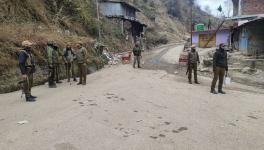Will a Stable Government in Myanmar End the Drug Problem in South and Southeast Asia?

Image Courtesy: UN News
The recent arrest of a retired Deputy Superintendent of Police for smuggling World is Yours (WY) tablets has brought to light one aspect of a problem that's affecting not just Manipur, the Northeast, or India, but the entire South and South East Asia. The quantity of tablets seized (1 lakh) in India has a value of around Rs. 4 lakh. However, on the international market it is believed to reach around Rs. 5 crores.
Ironically, the retired DSP had also served in the Narcotics and Affairs of the Border (NAB) division. This is the second major seizure involving a someone associated with the State machinery since 2013. Earlier, a Public Relations Officer (PRO) Colonel Ajay Choudhury of the Indian Army had been caught with pseudoephedrine tablets on his way to the Myanmar border at Moreh. However, the pseudoephedrine is not always smuggled in tablet form. In 2013, it was found that labs had been set up along the Manipur-Myanmar border to extract the main chemical in a usable state.
The WY tablets are actually a caffeine-laced methamphetamine preparation which goes by many street names -- one of them being Yaba. Yaba abuse is a noted problem in Thailand and had prompted many crackdowns on its users as well as those involved in its distribution. Of late, Yaba has been reportedly smuggled into Bangladesh by Rohingyas. According to various sources, the Yaba manufacturing factories are mostly located in the rebel-held territories in Myanmar, the most infamous being that of the United Wa State Army. However, Yaba manufacture requires a lot of precursor chemicals, one of the main ingredients is pseudoephedrine. Pseudoephedrine is a common ingredient in cold medications. The main problem for these manufacturers is that Myanmar does not have a strong pharmaceutical industry. Therefore, the supply of this ingredient comes from across Myanmar’s borders.
The supply of pseudoephedrine to Myanmar comes from India, China and Thailand. According to the United Nations Office on Drugs and Crime (UNODC) “China alone reported a combined 16.7 tons of the two precursors seized in bulk form in 2013, 31.5 tons of bulk ephedrine in 2014 and 23.5 tons of that same precursor in 2015. India also reported seizures of more than 10 tons of ephedrine and 8.5 tons of pseudoephedrine in 2016. Other notable seizures of pharmaceutical preparations in South-East Asia include seizures totalling 3.5 tons of pharmaceutical preparations of pseudoephedrine in Myanmar in 2013.” Therefore, the 2013 arrest of the PRO Colonel Ajay Choudhury as well as an MLA’s son, involved a seizure of the raw materials, whereas the present arrest of the retired DSP involved the final product.
The same UNODC report had highlighted that “[i]n 2015, the quantity of methamphetamine intercepted in East and South-East Asia surpassed the quantity intercepted in North America for the first time, making East and South-East Asia the leading subregions for methamphetamine seizures worldwide.” The report also mentioned “[i]n 2015, experts in several countries in the subregion reported a perceived increase in the use of both crystalline methamphetamine and methamphetamine tablets. They also considered methamphetamine to be the most commonly used drug in some of those countries. In the same year, people receiving treatment for methamphetamine use accounted for the largest share of people treated for drug use in the majority of countries and territories in East and South-East Asia that reported on that indicator.”

This map from the Narcotics Control Bureau (NCB) clearly shows India as a source country for pseudoephedrine. The point of exit is mostly in the Northeast, through either Manipur or Mizoram to Myanmar – though airports in Mumbai and Delhi are also some of the exits points. The source locations are, however, either in western India or in northern India, possibly due to lax enforcement. One cannot be sure whether pharmaceutical drugs are being diverted to fuel the manufacture of narcotics, or that the map represents a supply arising out of distributed individual purchases at a retail level.

This table from the NCB, however, shows a dramatic spike in the pseudoephedrine seizures in India in 2016. This coincides with the UNODC data for 2015. Possibly due to the increased demand for methamphetamines, the supply of pseudoephedrine over a year suddenly became a very lucrative business. However, on the other hand, it may indicate stricter enforcement in both China and Thailand. The choice of India as a drug precursor supplier probably has something to do with the booming generic drugs industry in the country.
But what makes Manipur and Mizoram choice locations for drug smugglers? One often-cited cause is the porous border. Another commonly cited reason is militant activity on both sides of the border. Security analysts often point the blame of drug trafficking on insurgent groups trying to raise funds. However, the evidence shows that this business is not limited to insurgent groups alone. Possibly, the most compelling factor is the unrest in Myanmar. The UNODC has, through its annual reports, shown that there is a direct correlation between unrest and trafficking, irrespective of the drugs, guns or humans. Therefore, a stable government in Myanmar and peace with the ethnic minorities following demilitarisation should be the endgame for both South and South East Asia.
Get the latest reports & analysis with people's perspective on Protests, movements & deep analytical videos, discussions of the current affairs in your Telegram app. Subscribe to NewsClick's Telegram channel & get Real-Time updates on stories, as they get published on our website.























